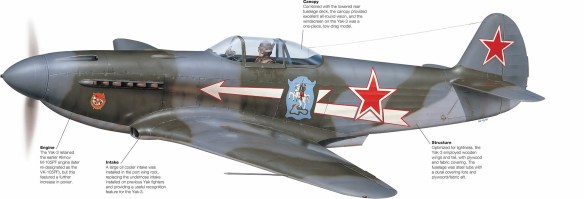A Yak-3 of the 303rd Fighter Aviation Division, First Soviet Air Army, on the 3rd Ukrainian Front, in 1944. Pilot of this aircraft was 303rd commander Georgii Nefedovich, who eventually accumulated 23 kills.
This Yak-9D was flown by the famous ‘Normandie-Niemen’ Regiment in 1944. This French-manned unit was established in 1943 and fought with distinction over Byelorussia and Lithuania.
A frontal view of the Yak-9D. The fighter utilized a lightweight armament comprising a single 20mm (0.79in) ShVAk firing through the spinner and one 12.7mm (0.5in) UBS machine gun.
The most important Soviet fighter line of World War II, the Yakovlev series of single-seaters were built in greater numbers than their contemporaries, and scored more victories than all other Soviet fighter types combined.
The first of the Yakovlev single-seat fighter dynasty was the Yak-1, product of a design competition launched in early 1939. From the start, the plan was to devise a fighter built around the Klimov M-105P inline engine with an integral cannon. The Soviet authorities also stipulated the use of wooden or composite materials. The resulting I-26 prototype took to the air in January 1940, a low-wing monoplane of welded steel tube and wooden construction. While the wing and tail unit had fabric covering, the forward fuselage had metal covering.
In May 1940 the I-26 was authorized for production, with the armament of a 20mm (0.79in) cannon firing through the propeller hub, and two machine guns mounted in the decking above the engine. While 18 pre-production Yak-1s were built in summer 1940, only 64 aircraft were completed in 1940; a second unit did not receive its aircraft until April 1941. Only one regiment in the west had re-equipped with the Yak-1 by the time of the German invasion in June 1941. As the Red Army was pushed back, Yak-1 production was moved to factories in Siberia and elsewhere.
While the pace of Yak-1 production increased, Yakovlev set about creating a stopgap solution to provide additional fighters for the Soviet Air Force. For this, the company took the Yak-7UTI, a two-seat trainer based on the Yak-1. In August 1941 the trainer model was reconverted to become a fighter – the Yak-7. This retained the rear cockpit canopy but demonstrated performance similar to the Yak-1, as well as additional fuel capacity. In September 1941, production of the Yak-7UTI trainer switched over to the Yak-7 fighter. In early 1942 the design was refined as the Yak-7A, with a re-modelled cockpit, while the Yak-7B of mid-1942 replaced the original 7.62mm (0.3in) machine guns with 12.7mm (0.5in) weapons.
In March 1942 a small batch of lightened Yak-1s was completed, featuring boosted M-105PF engines but with the machine guns deleted. June 1942 saw another addition to the line, the Yak-1b featuring a reduced-depth rear fuselage, and a new cockpit canopy improving all-round vision. This feature was adopted on subsequent Yak fighters. Armament comprised a 20mm (0.79in) cannon and one 12.7mm (0.5in) gun.
In a bid to counter the Bf 109F/G, both the Yak-1 and Yak-7B were re-engined with the M-105PF engine from August 1942, in time to see action over Stalingrad. Some Yak-7Bs were also completed with the M-105PA engine that incorporated a new 37mm (1.45in) cannon. After 8734 Yak-1s, production switched to the Yak-3 in July 1944.
In summer 1942, the availability of new alloys permitted new weight-saving features to be incorporated in the Yak-7, in turn allowing additional fuel capacity, and producing the long-range Yak-7D. In total, 6399 Yak-7s of all models were completed by the time production ended in July 1944. In June 1942 a Yak-7B fuselage and M-105PF engine had been combined with the wings of the Yak-7D, and a cut-down rear fuselage and canopy similar to the Yak-1B. The vacant rear cockpit area could be used to house additional fuel, small bombs or cameras. The resulting aircraft was ultimately designated Yak-9, and became the standard ‘heavy’ version in the Yak fighter line.
Numerically, the Yak-9 became the most important Soviet fighter of the war, and first saw significant action at Stalingrad. The new fighter replaced most of the earlier wooden components and featured an armament of one 20mm (0.79in) cannon and one 12.7mm (0.5in) machine gun. Production facilities gradually switched over from the Yak-7 to the Yak-9 and in the meantime some features of the former were included in production Yak-7Bs.
The Yak-3 was developed from the lightened Yak-1 of March 1942. Superbly agile, the Yak-3 served as the ‘light’ complement to the Yak-9, and was powered by a further boosted M-105PF. Other changes included the lowered rear deck and rear-view canopy, and a new wing of reduced span. The Yak-3 entered front-line service in spring 1944 and a total of 4848 Yak-3s of all sub-variants were produced by mid-1946, when production ended. The Yak-9 remained in production until late 1948, by which time 16,769 of these aircraft had been completed in a range of sub-variants. The key post-war versions of the Yak-3 and Yak-9 included the Yak-9P, which introduced all-metal construction and saw combat in the Korean War, and the Yak-3P, the latter featuring three-cannon armament and VK-105PF engine.
Wartime Yak-9 Variants
Yak-9Bs of the 130th Fighter Aviation Division wear the inscription ‘Little Theatre: Front’ (i.e., donated by Moscow’s Little Theatre to the Front). The Yak-7B was a fighter-bomber version, but was produced in only limited numbers. More successful was the Yak-9D long-range version with a range of 1360km (845 miles) thanks to additional fuel capacity in the former rear cockpit. The improved Yak-9DD increased range to 2285km (1420 miles) thanks to additional wing fuel tanks. The Yak-9T and Yak-9K were respectively armed with 37mm (1.45in) and 45mm (1.78in) cannon for anti-tank missions. Last of the wartime line were the strengthened Yak-9M and the Yak-9U with more powerful VK-107A engine.
Yak Piston Fighters
